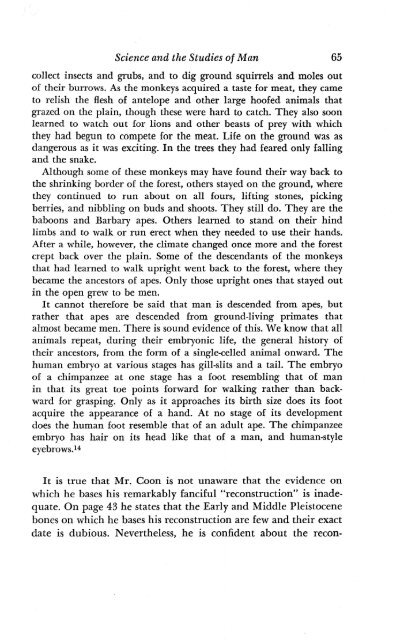Scientism and Values.pdf - Ludwig von Mises Institute
Scientism and Values.pdf - Ludwig von Mises Institute
Scientism and Values.pdf - Ludwig von Mises Institute
You also want an ePaper? Increase the reach of your titles
YUMPU automatically turns print PDFs into web optimized ePapers that Google loves.
Science <strong>and</strong> the Studies of Man 65<br />
collect insects <strong>and</strong> grubs, <strong>and</strong> to dig ground squirrels <strong>and</strong> moles out<br />
of their burrows. As the monkeys acquired a taste for meat, they came<br />
to relish the flesh of antelope <strong>and</strong> other large hoofed animals that<br />
grazed on the plain, though these were hard to catch. They also soon<br />
learned to watch out for lions <strong>and</strong> other beasts of prey with which<br />
they had begun to compete for the meat. Life on the ground was as<br />
dangerous as it was exciting. In the trees they had feared only falling<br />
<strong>and</strong> the snake.<br />
Although some of these monkeys may have found their way back to<br />
the shrinking border of the forest, others stayed on the ground, where<br />
they continued to run about on all fours, lifting stones, picking<br />
berries, <strong>and</strong> nibbling on buds <strong>and</strong> shoots. They still do. They are the<br />
baboons <strong>and</strong> Barbary apes. Others learned to st<strong>and</strong> on their hind<br />
limbs <strong>and</strong> to walk or run erect when they needed to use their h<strong>and</strong>s.<br />
After a while, however, the climate changed once more <strong>and</strong> the forest<br />
crept back over the plain. Some of the descendants of the monkeys<br />
that had learned to walk upright went back to the forest, where they<br />
became the ancestors of apes. Only those upright ones that stayed out<br />
in the open grew to be men.<br />
It cannot therefore be said that man is descended from apes, but<br />
rather that apes are descended from ground-living primates. that<br />
almost became men. There is sound evidence of this. We know that all<br />
animals repeat, during their embryonic life, the general history of<br />
their ancestors, from the form of a single-celled animal onward. The<br />
human embryo at various stages has gill-slits <strong>and</strong> a tail. The embryo<br />
of a chimpanzee at one stage has a foot resembling that of man<br />
in that its great toe points forward for walking rather than backward<br />
for grasping. Only as it approaches its birth size does its foot<br />
acquire the appearance of a h<strong>and</strong>. At no stage of its development<br />
does the human foot resemble that of an adult ape. The chimpanzee<br />
embryo has hair on its head like that of a man, <strong>and</strong> human-style<br />
eyebrows. l4<br />
It is true that Mr. Coon is not unaware that the evidence on<br />
which he bases his remarkably fanciful "reconstruction" is inadequate.<br />
On page 43 he states that the Early <strong>and</strong> Middle Pleistocene<br />
bones on which he bases his reconstruction are few <strong>and</strong> their exact<br />
date is dubious. Nevertheless, he is confident about the recon-
















